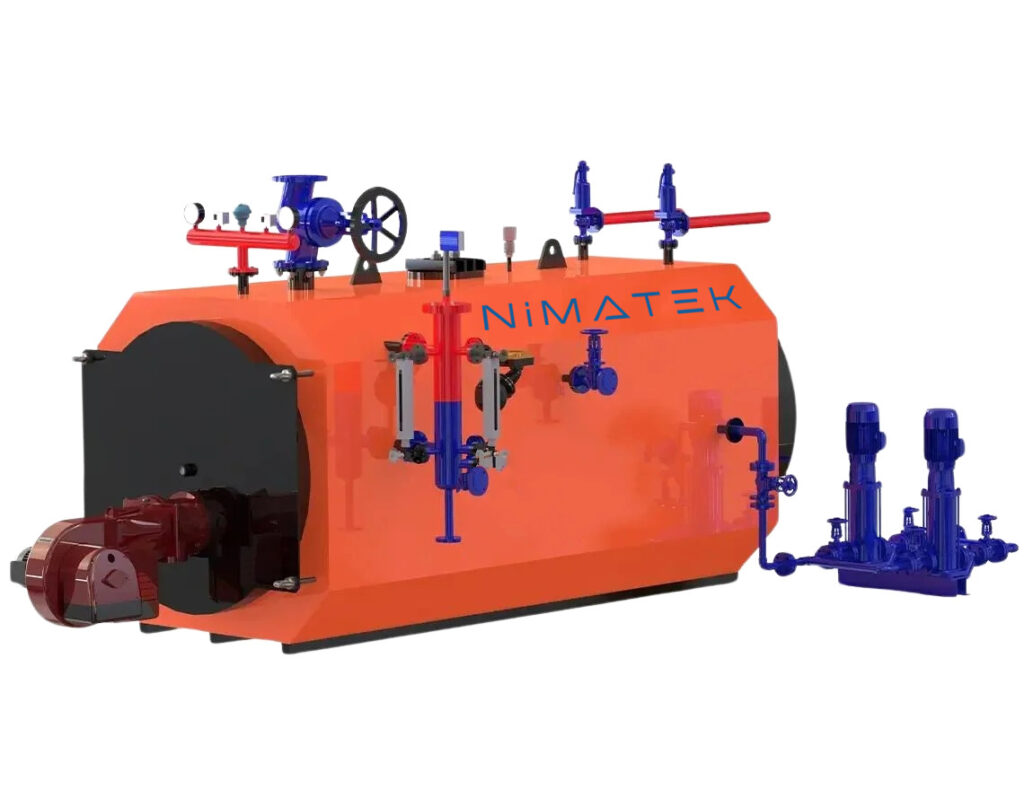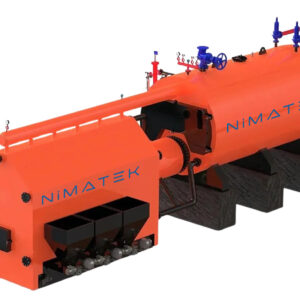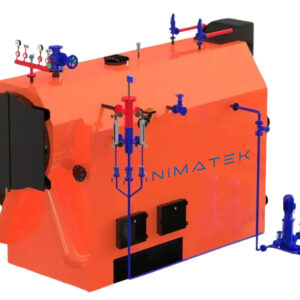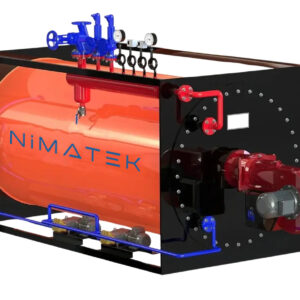Steam Production Capacity
200 kg/h – 4.000 kg/h
Working Pressure
3 – 16 Bar
Design Type
Fire – Smoke Tube, Reverse Pressure, Type 2 Pass
Fuel Type
Liquefied Natural Gas, Propane, Compressed Natural Gas, Natural Gas, Liquefied Petroleum Gas, Biogas, Diesel Fuel, Diesel Fuel, Fuel Oil.
Heat Capacity
125.000 Kcal/h – 2.500.000 Kcal/h
Counter pressure steam boilers are highly efficient due to their optimal use of fuel energy. Strong insulation with stone wool prevents heat loss. The use of smoke redirecting turbulators in the boiler tubes ensures maximum efficiency and maintains low chimney temperatures by increasing the contact time and surface area of the smoke gases with the tubes.
Key Features of Ekotek Counter Pressure Steam Boilers:
- High Efficiency: The design maximizes fuel energy use, leading to higher efficiency.
- Strong Insulation: Stone wool insulation prevents heat loss.
- Smoke Redirecting Turbulators: Increase the efficiency and reduce chimney temperatures by enhancing the contact time and surface area of smoke gases with the tubes.
Safety Systems:
Ekotek Heating Technologies incorporates five types of safety systems in their counter pressure steam boilers:
- Steam Temperature Control
- Mechanical Pressure Control
- Digital Pressure Control
- Safety Valve
- Chimney Temperature Control
Additionally, all safety systems, including boiler feed pumps, are standard in a double package. An optional PLC control system can be added for enhanced control.
Advanced Control Options:
For those seeking more control, optional features include a PLC touch screen control and Modbus RTU (Remote Terminal Unit) integration, allowing complete management of the boiler’s operation.
Silent Operation and Robust Design:
Ekotek boilers operate quietly, avoiding noise pollution. They are corrugated according to pressure values, increasing the boiler’s strength and resistance to thermal stresses. Smoke tubes are welded with mirrors for safer and longer operation, and the smoke box includes an explosion cap and cleaning cap for added safety.
User-Friendly Design:
The boilers are designed for easy installation and maintenance. They feature burner combustion control to ensure minimum fuel consumption and reduced operating costs. Their compact size allows them to fit in various environments, and their stylish appearance ensures compatibility with the surrounding decor.
Optional Package Delivery:
Upon request, Ekotek steam boilers can be delivered as a complete package with all necessary accessories.
Liquid – Gas Fired Steam Boiler Working Principle
The working principle of liquid – gas fired steam boilers is based on heating water to generate steam through the combustion of fuel. The fundamental working principle of liquid – gas fired steam boilers can be outlined as follows:
-
Fuel Feeding: A suitable type of fuel (liquid or gas) is fed into the steam boiler. Liquid fuels, commonly fuel oil, and gas fuels like natural gas or LPG are used.
-
Combustion Chamber: The fuel is burned in a combustion chamber where the combustion process is controlled, and hot gases are produced.
-
Heating Surfaces: The resulting hot gases are directed to heat transfer surfaces. These surfaces can consist of pipes or plates through which water flows. Heat transfer surfaces heat the water in the boiler, facilitating energy transfer.
-
Transfer of Heat to Water: The hot gases come into contact with the water surrounding the heating surfaces, causing the water’s temperature to increase.
-
Vaporization: The heated water begins to vaporize. As the water’s temperature reaches its boiling point, it starts transitioning to steam.
-
Steam Formation: Water molecules that vaporize separate from the water surface, forming steam that gathers above the water level.
-
Steam Collection: The produced steam collects in a collection chamber at the top of the boiler. It is then taken out from there and can be used for energy transfer.
-
Steam Usage: The generated steam is directed towards systems requiring energy transfer. These systems often involve steam turbines or heating systems.
-
Exhaust of Flue Gases: At the end of the process, the flue gases resulting from combustion are expelled to the outside through chimney stacks or exhaust systems.
The working principle of liquid – gas fired steam boilers shares similarities with the basic principle of steam boilers. However, due to the use of different fuel types, the combustion process and stages of heat transfer can vary based on the characteristics of the fuel.





